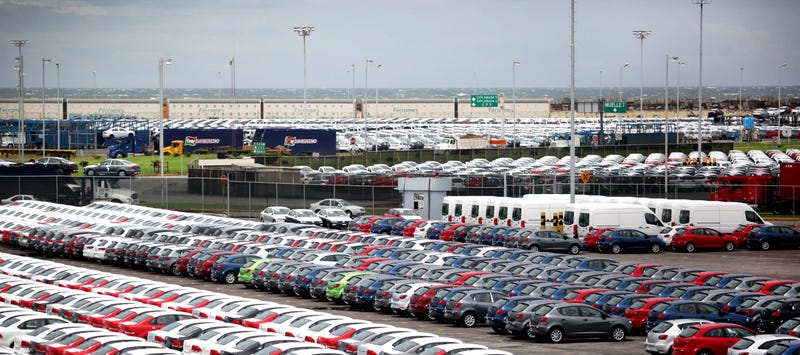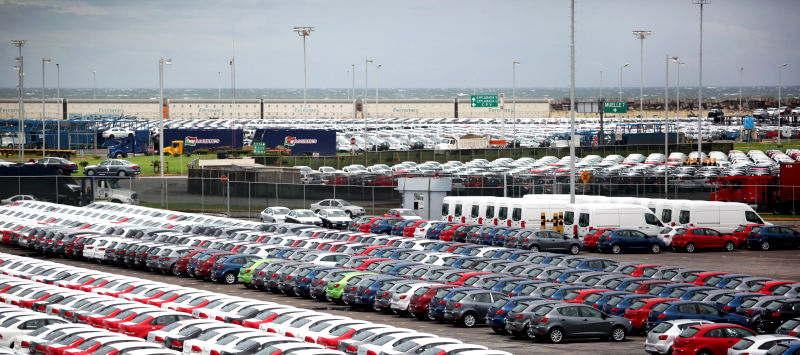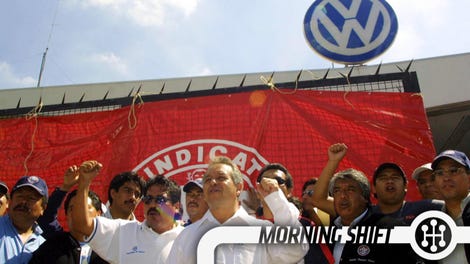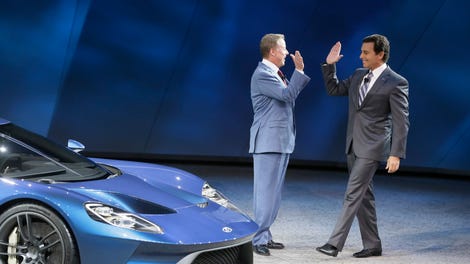
Trade. It has a nice connotation: You give me this, I’ll give you something of equal value in return. When it comes to trade deals—the North American Free Trade Agreement, in particular—the connotation isn’t so pleasant. Incoming U.S. President Donald Trump went after it heavily this during the election cycle. But what is NAFTA, and why does he want to kill it, or at least significantly rework it?
For anyone who hasn’t read a news story in the last 18 months, Trump ascended to the White House, in part, on a wave of resentment toward NAFTA and other trade deals. Along the way, he threatened to hit car companies with huge tariffs for producing cars in Mexico and importing them to the U.S. for sale.
Advertisement
Advertisement
And so far, automakers seem happy to oblige the former reality show star, saying he’s not the cause of their recently-announced decisions to heavily invest in the U.S.—yet they’ve still allowed him to take a victory lap every time a new domestic investment project has been unveiled.
Perhaps that’s the smart move. Trade appears to be an issue Trump has remained consistent about through the election and its aftermath. He also says he’d like to lower corporate income taxes, an idea automakers are surely invested in. But Trump has maintained that he wants to implement a 35 percent tariff on all vehicles and parts imported into the U.S. The impact of this? Let’s just say it wouldn’t be the smoothest ride.
What Are We Talking About Here?
NAFTA, a nearly quarter-century old agreement that was signed in the waning days of George H.W. Bush’s administration, eliminated most tariffs on products traded between the U.S., Canada and Mexico. The deal was uncontested by Bush’s successor, Bill Clinton, who said it was an “important step” toward integrating North America’s economy. Clinton expressed caution about implementing safeguards to stave off any trade “surges,” the Baltimore Sunreported at the time, but felt it could be accomplished without renegotiating the agreement.
Sponsored
And beyond cars and auto parts, NAFTA covers an array of products, like textiles, clothing and fibers.
“I will pursue those other things that I think need to be done in the public interest, then I will prepare implementing legislation and try to pass it in Congress,” Clinton said.
Advertisement
The deal wasn’t produced in a vacuum. The Sun’s report in 1992 noted that unions and environmentalists alike sounded the alarm about the deal as a threat to U.S. jobs and said it would serve as a mechanism to implore companies to set up shop in Mexico, “where pay is lower, and worker health and safety standards are less strict.”
In the automotive sector, NAFTA has resulted in a tremendous growth in Mexican car production to serve both the U.S., the world’s second largest car market behind China, and other markets too. At least until Trump was elected, those investments in Mexico seemed poised to only grow, as automakers from BMW to Fiat Chrysler to Honda planned more and more plants there, especially to produce small cars.
Advertisement
At the same time, those critics from the early 1990s sound prescient. NAFTA is blamed for decimating the U.S. manufacturing sector, accumulating significant job loses, as well as generating a groundswell of support for Trump when he first started slamming the deal.
But what happens if Trump decides to remove the U.S. from NAFTA?
Leaving NAFTA Would Cost More Jobs, New Study Says
In a well-timed study released this month, the Michigan-based Center for Automotive Research delivered some findings that show how deeply entrenched NAFTA’s effects have become.
Advertisement
The study—which, it should be noted, was funded by the Alliance of Automobile Manufacturers—said that withdrawing from NAFTA while implementing a 35 percent tariff would lead to a spike in vehicle prices, and cost the U.S. upward of 31,000 jobs.
“Any move by the United States to withdraw from NAFTA or to otherwise restrict automotive vehicle, parts and components trade within North America will result in higher costs to producers, lower returns for investors, fewer choices for consumers and a less competitive U.S. automotive and supplier industry,” the report said, according to Automotive News.
The CAR report suggested Trump’s trade and tariff promises are bluster, and would likely have an adverse impact on the economy that he never expected. From Automotive News:
Advertisement
Advertisement
For instance, a 35 percent tariff on vehicles imported from Mexico would result in the loss of at least 6,700 North American assembly jobs and 450,000 units of U.S. auto sales, according to CAR.
The tariff itself, if Trump were to implement it against a single company, would likely violate NAFTA, according to a report from Bloomberg. And Trump’s (half-wrong) tweet about General Motors, in which he threatened it with a tariff, could prompt retaliation from Mexico, Bloomberg notes, potentially raising prices on good that are imported from the country.
“The notion of using emergency tariff-raising authority to influence the investment location decisions of a single company would be an unprecedented use of that authority and far beyond what Congress ever intended,” Edward Alden, a trade expert at the Council on Foreign Relations, told Bloomberg. “Turning those powers on a single U.S. company because you don’t like its strategy just takes us to a whole new realm.”
As we noted this month, despite NAFTA, there’s still plenty of cars produced in the U.S. Small car production has generally been shifting to Mexico because profit margins in the business are thin, especially with cheap gas shifting America’s car market toward larger trucks and SUVs. If those margins are scrapped, the cars are eliminated, thereby hurting the U.S. auto industry. The cost could jump anywhere from $5,000 to $15,000.
But Can Trump Unilaterally Withdraw The U.S.?
Sure. NAFTA has a clause that allows any of the three parties involved in the deal a chance to back out with six months notice. “If a party withdraws, the Agreement shall remain in force for the remaining Parties,” it reads.
Advertisement
Advertisement
We haven’t faced a situation where a sitting president threatened to remove the U.S. from the trade deal, so there’s some disagreement over whether Trump could unilaterally withdraw from NAFTA without Congress, which approved the treaty through statute. But the overwhelming consensus appears to be that NAFTA’s withdrawal clause would empower Trump to act on his own.
Investor’s Business Dailysays the implementation legislation for NAFTA also allows for pre-1994 tariffs to be reintroduced if the U.S. withdraws from the agreement, and also “gave the president authority to apply additional tit-for-tat duties to offset moves by Mexico (or Canada) that tilt the terms of trade.”
Trump could also reopen negotiations for the treaty. Canada’s prime minister, Justin Trudeau, has signaled his support of the move; Mexico has not. Regardless, Trump’s incoming administration has reportedly informed Canada that formal-notification letters to reopen NAFTA will be sent to Canada and Mexico within days of the inauguration.
Advertisement
The Globe and Mail reports that Trump’s team wants to discuss what’s known as “country of origin rules.”
Country of origin rules, which govern how much content from outside NAFTA a product can contain and still qualify to be shipped duty-free, are specific to each product and spelled out in writing. They cover every kind of good and service, from suits to cars. The Trump administration is expected to take a harder line on exactly what can cross the border duty-free.
A government official in Canada told the newspaper that Trump’s trade officials have indicated its renegotiation efforts will focus on Mexico, which the Globe and Mail says would “essentially [cut] the United States’ southern neighbour out of many NAFTA benefits.”
In other words, Trump’s not kidding around about trade.
Can Trump Legally Implement A 35 Percent Tariff?
He can try, but it’s not like affected companies wouldn’t contest it. The Bloomberg report said a legal challenge to a Trump tariff has a good shot of prevailing in court. Gary Hufbauer, a former U.S. government tax and trade official, told the news organization that the 1970s law Trump would lean on to implement a tariff is meant to target countries, not a corporation.
Advertisement
Advertisement
That would differentiate from a similar maneuver made in 2009 by the Obama administration. As Investor’s Business Daily notes, Obama imposed a 35 percent tariff on Chinese tires in wake of a U.S. International Trade Commission finding that China was “dumping steel in America at artificially low prices.”
But a withdrawal from NAFTA won’t exactly allow Trump to automatically impose a 35 percent tariff, either, according to Bloomberg.
Duties on goods produced in Mexico would only rise to the rate for countries with “most favored nation” status in the U.S.: about 4 percent, said Doug Irwin, an economist and trade expert at Dartmouth College.
Trump could impose 15 percent duties for 100 days on GM’s cars, claiming a “balance payments emergency,” but that would fall short of the punishment he’s threatened. Other fines, such as anti-dumping duties, require special and lengthy procedures to enact. For his 35 percent tariff to stick, Trump would likely have to ask Congress to include it in a broader overhaul of the U.S. tax code.
So Trump’s effort to follow through on his trade promises sounds iffy, at best. If he succeeds, the ramifications could be as vast as a full-blown trade war with Mexico, as a September report from the Washington D.C. think-tank Peterson Institute for International Economics described in what’s basically a worst-case scenario:
Advertisement
No matter the outcome of domestic legal battles, if Trump is elected, if he actually withdraws from US trade agreements, or if he imposes high tariffs, even as a threat or tactical maneuver, foreign countries will soon retaliate. They will not patiently wait for US court proceedings or litigation in the [World Trade Organization] to vindicate their claimed rights under international law—specifically the right to export to the US market at low (bound) tariffs or duty free. Enormous economic damage to US firms, workers, and communities could ensue from a trade war long before the legal battlefield is cleared. It would be a mistake to suppose that the US courts will intervene to stop a trade war.
Trump is finding, however, that some resistance to his plan may exist in the Republican-controlled U.S. Congress. House Republicans have a corporate income tax plan themselves, in what’s known as a “border adjustment.” Unlike Trump’s plan, what’s being offered in the their tax proposal, according to the Wall Street Journal, is: a reduction the corporate income tax rate from 35 percent to 20 percent (Trump’s plan aims for a 15 percent rate), a tax on imports, while exports would be exempt.
Trump’s 35 percent tax focuses on “goods made by companies that shift production out of the U.S. and then sell back in,” as the Journal reported.
Advertisement
Advertisement
The border adjustment isn’t supported by Trump.
“Anytime I hear border adjustment, I don’t love it,” he told the Journal. “Because usually it means we’re going to get adjusted into a bad deal. That’s what happens.”
Regardless, Trump’s trade rhetoric resonated with the public. So it’s worth asking: What impact has NAFTA had on the economy?
Has NAFTA Actually Caused The U.S. To Lose Jobs?
Yeah, but to what extent depends on who you ask.
Advertisement
The Economic Policy Institute observed in 2013 that NAFTA “undercut the bargaining power of American workers, which had driven the expansion of the middle class since the end of World War II.” That included significant job loss:
NAFTA affected U.S. workers in four principal ways. First, it caused the loss of some 700,000 jobs as production moved to Mexico. Most of these losses came in California, Texas, Michigan, and other states where manufacturing is concentrated. To be sure, there were some job gains along the border in service and retail sectors resulting from increased trucking activity, but these gains are small in relation to the loses, and are in lower paying occupations. The vast majority of workers who lost jobs from NAFTA suffered a permanent loss of income.
But in 2015, the Congressional Research Service concluded that the impact on the U.S. economy hasn’t been as drastic as Trump may think.
Advertisement
“The net overall effect of NAFTA on the U.S. economy appears to have been relatively modest, primarily because trade with Canada and Mexico accounts for a small percentage of U.S. GDP,” the service wrote. “However, there were worker and firm adjustment costs as the three countries adjusted to more open trade and investment among their economies.”
The report cited a previous study by the Congressional Budget Office, which said it’s honestly a crapshoot figuring out the exact impact of NAFTA. A 2003 study estimated full implementation of NAFTA would increase U.S. GDP by 0.1-0.5 percent.
Advertisement
But putting Rust Belt factories in competition with neighboring countries has certainly left a personal scar for factions of Trump’s base that flocked to him for his trade rhetoric. The New York Times notes that while the American trade deficit in autos and parts tripled after NAFTA was implemented, the “industry lost 350,000 jobs, or about a third of its workers, over the [same] period.”
Still, the Times goes on to highlight how NAFTA may actually have saved automotive jobs. Godon Hanson, a University of California professor who studies the impact of NAFTA, asserted to the newspaper that moving lower-wage jobs to Mexico actually helped maintain the entire automotive industry in the U.S. From the Times:
The integration of production across countries with complementary labor forces — cheaper workers in Mexico to perform many basic tasks, with more highly paid and productive engineers and workers in the United States — turned out to play a central role in reviving the auto industry in North America.
In the final analysis, Nafta might have saved hundreds of thousands of jobs. By offering a low-wage platform, Mexican plants increased the scale of production in North America, allowing domestic and foreign automakers to amortize their large fixed costs. Carmakers and parts suppliers tend to cluster relatively close together. So assembly plants in Mexico help sustain a robust auto-parts industry across North America.
The rub? We’re entering a precarious and volatile period, plain and simple. NAFTA had a notable impact on large cities in the Midwest and elsewhere, but for how integral it is to the U.S. economy as of today, unwinding it portends a scenario that, honestly, we probably couldn’t grasp unless it went forward. We could soon find out.


















